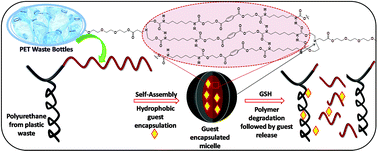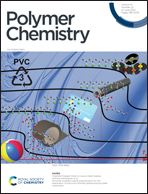Supramolecularly cross-linked nanoassemblies of self-immolative polyurethane from recycled plastic waste: high encapsulation stability and the triggered release of guest molecules†
Abstract
Stabilizing noncovalently encapsulated guest molecules inside a nanoassembly constructed from amphiphilic polymers has become a very challenging task in the area of targeted drug delivery for biomedical applications. Unwanted disassembly followed by the premature release of guest molecules can limit the applicability in this field. Hence, designing a robust nanocarrier with efficient noncovalent encapsulation stability would be highly desirable. Here, recycled plastic waste is used to synthesize new self-immolative amphiphilic polyurethane equipped with a redox-responsive disulfide bond, tertiary amine and aromatic moieties on the backbone and periodically implanted triethylene glycol monomethyl ether as a pendant. In aqueous environments, this polymer self-assembles into a smaller micelle-type nanoassembly, which shows nanocontainer properties via the stable encapsulation of hydrophobic guest molecules. In addition to hydrophobic interactions, supramolecular cross-linking in the core via π–π stacking (aromatic moiety) and H-bonding (urethane functionality) interactions brings stability to the micellar nanostructure, which eventually amplifies the guest encapsulation stability, and this was further confirmed via computational studies. As the backbone is integrated with a self-immolative redox-responsive linker, which can be cleaved in the redox environment of cancer cell cytoplasm, guest release experiments in the presence of glutathione (GSH) were carried out, and they resulted in ∼70% guest release in a controlled fashion. Furthermore, the tertiary amine present in the polymer backbone leads to tumor-relevant pH (pH: ∼6.5–6.8) regulated charge modulation and the formation of a positively charged nanoassembly, which is very relevant for enhanced cellular internalization as the cell membrane has a negative potential. Thus, the utilization of recycled plastic waste to fabricate a biodegradable polyurethane-based supramolecular cross-linked stable micellar nanostructure endowed with environment-specific surface charge modulation and controlled guest release, we believe, will have a significant impact on the ongoing efforts of scientists to find stable nanocarriers with higher encapsulation efficiencies for improved chemotherapeutic applications.

- This article is part of the themed collections: Polymer Chemistry Recent HOT Articles and Plastic Waste Utilisation: A cross-journal collection


 Please wait while we load your content...
Please wait while we load your content...